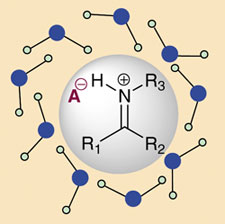Scientists report the first example of Brønsted acid asymmetric catalysis in aqueous solution.
Water is an attractive reaction medium as it is cheap, clean, non-toxic and non-flammable. Also, its high heat capacity makes it ideally suited to exothermic reactions on an industrial scale. There are a number of reports of metal catalysed asymmetric reactions in the presence of water, as well as organocatalytic reactions involving covalent bonding, but until now a non-covalent, asymmetric organocatalytic reaction has remained elusive.
Magnus Rueping and Thomas Theissmann at Aachen University, Germany, performed enantioselective hydrogenation of quinolines using a chiral phosphoric acid catalyst in water. Phosphoric acid forms a hydrogen bond with the quinoline, and directs the dihydropridine hydride donor to a particular face.
This hydrogen-bonding catalysis occurs despite the fact that water is an excellent hydrogen donor, due to the phenomenon of ‘hydrophobic hydration’. Interaction between water molecules at the hydrophobic-hydrophilic interface causes the contact surface between water and substrate molecules to be minimised, reducing the possibility for water to participate in hydrogen-bonding, explains Rueping. The selectivity of the catalyst was further improved by adding bulky organic side chains that create a hydrophobic pocket for the substrate.
Rueping says, ‘Non covalent asymmetric activation in aqueous solution has been considered impossible due to fast proton transfer in protic media. Our solution based on the principle of hydrophobic interaction allowed us to develop a Brønsted acid catalysed reaction in aqueous solution that provides the products in good yields and with excellent enantioselectivities.’
Peter Dalko from the Paris Descartes University in France says, ‘the discovery of the efficient reaction conditions is only part of the cake, since the rational behind the observed selectivity is also worth reflection. Hydrophobic interactions are well known in enzymology and are evoked to explain stereoselectivity in many enzymatic transformations. This concept is now emerging in chemistry as a major paradigm.’
Rueping is confident that it could be carried out on a larger scale. ‘Typically we use one equivalent of the dihydropyridine, but for large scale processes catalytic amounts of hydride donor would be used. Given that recycling of dihydroypyridines in water is already possible, the new Brønsted acid catalysed process in aqueous solution paves the way for large scale application.’
Jacob Bush











